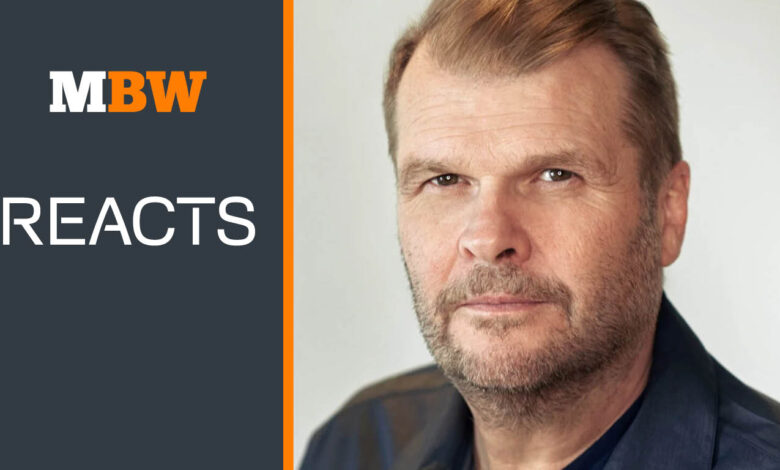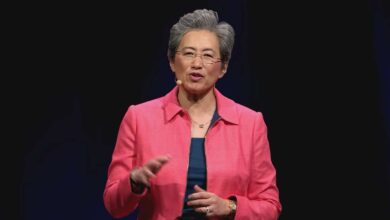Sony Music Group boss Rob Stringer talks acquisitions, artificial intelligence and how music streaming services should start charging free users

Music recording companies have been urging streaming services to raise their subscription prices for some time now, and over the past 18 months, they’ve succeeded, with most of the major DSPs hiking prices.
Some in the music industry have hinted these price hikes – typically an increase of $1 per month for individual subscriptions – isn’t quite enough to keep up with inflation.
But Sony Music Group Chairman Rob Stringer is setting his sights on another monetization goal: Getting the music streaming services to start charging for their ad-supported subscription tiers.
During his presentation at Sony Group’s annual Business Segment Meeting on Thursday (May 30), Stringer suggested that DSPs start charging a “modest fee” on their free subscription tiers.
“While free tiers attract billions of monthly users, their poor contribution to streaming monetization means their primary purpose is to convert users into paying subscribers,” Stringer said.
“The value of the paid music product remains incredible. And we appreciate that our partners recognized that with price increases over the past year. However, it also highlights that the price gap between free and paid has gotten wider in mature markets. We hope that our partners close that gap by asking consumers using ad-supported services to additionally pay a modest fee.”
Stringer’s comments come in the wake of price hikes at Spotify, Apple Music, YouTube Music, Deezer and other services.
They also come as Spotify rolls out its second wave of price hikes in as many years, and as the biggest subscription music streaming service works on greater segmentation of its subscription tiers. One aspect of that segmentation – the bundling of its Premium paid subscriptions with audiobooks, resulting in Spotify paying out lower mechanical royalties in the US – has proven controversial. (More on that below.)
“While free tiers attract billions of monthly users, their poor contribution to streaming monetization means their primary purpose is to convert users into paying subscribers.”
Rob Stringer, Sony Music Group
At Spotify and many other DSPs, free subscribers make up a solid majority of music listeners, but the ad revenue generated from those users is small compared to the revenue generated from paid subscribers.
In Q1 2024, Spotify reported 236 million paying subscribers worldwide, out of a total of 615 million monthly active users. But while paid subscription revenue came in at €3.247 billion (USD $3.525 billion), ad-supported revenue was €389 million ($422.37 million), barely more than 10% of the total.
On the investor call, Stringer argued that adding a fee to ad-supported subscriptions would help evolve that segment of the market “to be more than just a marketing funnel for paid subscription, and still be a tremendous value for users… At Sony Music, we think everyone is willing to pay something for access to virtually the entire universe of music.”
The investor call took place a few weeks after Sony’s latest earnings report, which showed its music rights operations globally brought in $2.50 billion in the first calendar quarter of 2024, an increase of 14.7% YoY.
Recorded music operations generated $1.94 billion in the quarter, up 15.5% YoY, while music publishing operations brought in $558.6 million, up 12.1% YOY.
Elsewhere during the presentation, Stringer touched on everything from Sony’s M&A strategy and expansion in emerging markets, to the ongoing dispute over Spotify’s bundles, and Sony’s efforts to ensure that AI is developed responsibly.
Besides Sony’s take on ad-supported streaming services, here are five other things we learned from Rob Stringer’s presentation at Sony’s business segment meeting:
1) Sony issued 20,000 takedown notices on AI-generated content over the past year
Sony Music is proving to be among the more aggressive music companies when it comes to policing AI-generated content copyright violations.
Earlier this month, the company sent out letters to 700 AI developers and music streaming services, notifying them that its recording and publishing divisions are “opting out” of having their material used to train AI models (though Sony is open to negotiating licensing deals).
The letter also suggested that some of these AI developers may have already violated Sony’s copyrights.
During the investor presentation on Thursday, Stringer unveiled another interesting fact: Sony has issued 20,000 takedown notices for “AI-generated soundalikes” over the past year.
The company’s been busy: As recently as last November, Dennis Kooker, Sony Music Entertainment‘s President of Global Digital Business & US Sales, estimated that Sony had issued half that amount, or around 10,000 takedown notices.
“Artificial Intelligence represents a generational inflection point to music and content in general. A sustainable business rights model needs to be established and respected.”
Rob Stringer, Sony Music Group
The number illustrates not only that Sony is devoting considerable resources to fighting copyright-infringing AI content, but the scale of the problem as well. AI has the capacity to create enormous amounts of content, posing a serious problem for rights holders. (AI music generator Suno recently said that, in the eight months its platform has been open to the public, users have created 10 million new tracks, and there’s reason to believe that Suno’s AI was trained on copyrighted material without authorization).
“Whilst we’re optimistic about [AI], we are not naive about how complex protecting our art form will be,” Stringer said. “We won’t tolerate illicit training of AI models by reckless and unlicensed misuse of this art. We believe strongly that permission is the only way AI models can be trained with our content.”
Said Stringer: “Artificial Intelligence represents a generational inflection point to music and content in general. A sustainable business rights model needs to be established and respected. And we will take an active role in bringing one about.”
He added that over the past year, Sony has met with more than 350 tech organizations to work on initiatives involving AI.
“We will go where our artists want to go creatively in the AI space while protecting their rights every step, and we look to find common ground with our future partners in this era,” Stringer said.
“With the right frameworks in place, innovation will thrive, technology in music will benefit, and consumers will enjoy new experiences.”
2) Sony wants to see better monetization of short video platforms like TikTok
Getting DSPs to charge for ad-supported subscription tiers isn’t the only way Sony Music aims to improve monetization: Stringer also focused on the booming field of short-video social media platforms.
“The expansion of short content has been rapid, driving total audio streaming consumption growth,” Stringer said. “We see similar commercial potential as with full-track streaming, but some of the leading platforms must deliver greater value.”
Though the Sony Music chief didn’t mention it by name, it’s a sure bet that TikTok – with its 1 billion users worldwide and focus on videos featuring music – was a prime target of his comments.
Notably, Stringer’s comments about short video platforms “delivering greater value” come just weeks after TikTok and Universal Music Group announced they had come to a new licensing agreement for UMG’s music on the platform.
“These companies play a larger and larger role in music discovery and engagement amongst young listeners. More and more these are primary consumption sources, and they need to be valued accordingly.”
Rob Stringer, Sony Music Group
The deal came after an unnerving few months during which UMG’s recorded and publishing catalogs were unavailable on TikTok once the old licensing agreement expired without a new one in place.
According to UMG, the new agreement will mean better payment for artists – something that may have inspired Stringer to focus on Sony’s own arrangements with short-video platforms.
“Our premium quality artistry drives the appeal of these services, with music being central to approximately 70% of videos created on them,” he said. “These companies play a larger and larger role in music discovery and engagement amongst young listeners. More and more these are primary consumption sources, and they need to be valued accordingly.”
During a Q&A session, Stringer said that income from short-video platforms amounts to a “single digits” percentage of Sony’s revenue, and “that isn’t where we’d like it to be… We are constantly, I think, as an industry, fighting to get that number up.”
3) Sony is working ‘amicably’ with Spotify to resolve the mechanical royalty ‘loophole’
Asked about the ongoing conflict between Spotify and music publishers in the US over its payment of mechanical royalties, Stringer said Sony’s publishing division is working “amicably” with Spotify to resolve the issue – though he made it clear he wants to see Sony paid the same rates as Spotify was paying before it converted its Premium service to a “bundle.”
Under the Phonorecords IV rules established by the US Copyright Royalty Board, streaming services can pay out a lower mechanical royalty rate to publishers if the money comes from a “bundled” service than if it comes from a standalone music service.
Spotify announced in March that it now considers its Premium subscriptions – Individual, Duo and Family plans – to be bundled services, as they now include 15 hours of audiobooks per month.
That raised the ire of many publishers, and resulted in the Mechanical Licensing Collective (MLC) taking Spotify to court, arguing that its Premium bundles aren’t bundles at all, but an excuse to pay less to music rightsholders.
“We have a very good relationship with Spotify, but we think there’s a loophole that has affected our royalties in publishing, on mechanical, so we are looking to fix that amicably now with Spotify, because we think that they used a loophole,” Stringer said on the investor call.
“And the publishing community will… fight that battle, quite rightly too. But in terms of bundling, we are always aware of what the value of music is on its own, and if it is in a bundle, [then] we look to extract the exact value, on the audio side, that we had in the original deal.”
4) Sony has grown its US market share for 5 straight years
Stringer said Sony’s recorded music current market share in the US rose in 2023 for the fifth year in a row, with its frontline catalog reaching a new peak of 27% of overall consumption.
Sony’s recording artists accounted for five of the top 10 Billboard Hot 100 artists, and worldwide, Sony artists spent 30 of 52 weeks at number one on the Billboard Global 200 over the past year.
Among the notable successes of the past year, Stringer mentioned Miley Cyrus’ Flowers, “which ended up being the biggest-selling song in the world in 2023 and winning the Record of the Year at the recent Grammys.”
He also noted that in just the past month, Sony released number-one albums from Future and Beyonce.
“Now we have the advantage of delivering strong catalog sales in the years to come,” he said.
And Stringer isn’t shy about where Sony’s growing prominence is coming from: The company’s robust M&A activity.
“We are undoubtedly the most aggressive major music group in M&A over the last three years,” he said, noting some of the many acquisitions that have helped build the business on the recording and publishing sides in recent years, including its acquisition of music distributor The Orchard in 2015 and artist services company AWAL in 2022.
“This broad-based strategy has culminated in 24% more new released tracks distributed to DSPs in fiscal year 2023 versus fiscal year 2019. And on the publishing side that’s translated to 28% more songs administered over fiscal year 2019,” Stringer said.
5) Sony was the only global music major with artists among the top 10 streaming acts in China in 2023
Sony’s M&A strategy has also focused on emerging markets, where Stringer says the company has clocked a number of achievements.
“Key artist signings and strategic label deals supplemented our footprint in China. We’re the only global company to have artists represented on the leading top 10 streaming charts in the region,” Stringer said.
Sony has certainly been busy in the Chinese market in recent years, with notable moves including launching a record label jointly with Tencent Music Entertainment in 2018, and expanding the RCA Records brand to the country in 2022.
Additionally, “we have focused our attention on the rapidly developing India, where we are the number one major music company,” Stringer said, noting that the company this year acquired film and music company Eros (with which Sony has had a partnership since 2020), and expanded AWAL’s presence in the country through new partnerships.
“We are the leader in the Latin region, where so much of the music and the global streaming charts now comes from,” Stringer added, noting that Sony has “heavily invested” in Rimas, the label behind Bad Bunny.
Stringer also disclosed that Sony Music has “recently bought top Spanish independent label Altafonte” and added that “we are now through the second year of our integration of the Brazilian label Som Livre.”
Brazil’s competition watchdog CADE (Conselho Administrativo de Defesa Econômica), approved Sony Music’s $255 million acquisition of Som Livre, the owner of Brazil’s biggest domestic record label, in 2022.
According to a press release issued by Spain’s competition regulator in December, Sony’s acquisition of Altafonte, via Sony Music Entertainment España, SL, was cleared in November.
Meanwhile. Sony saw a 19% YoY market increase in Africa, where the company represents “four of the continent’s biggest stars,” namely Davido, Wizkid, Tems and Tyla, Stringer noted.
“New investment will be vital in future years to ensure our powerhouse status worldwide,” he said.Music Business Worldwide



